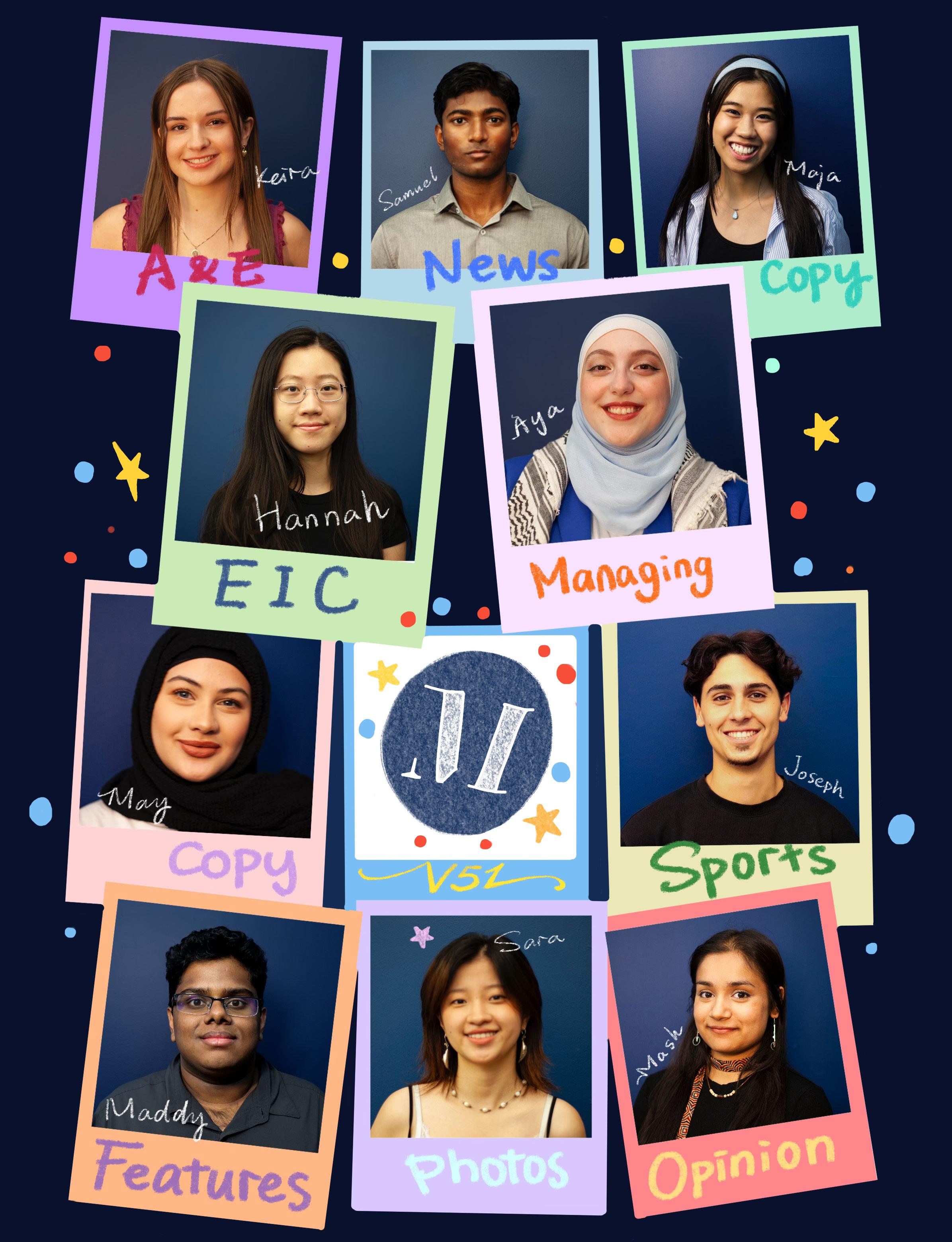

02 NEWS
UTMSU end of year recap: Striving for affordability and solidarity
Diana Fu Associate News Editor
In an interview with The Medium, UTMSU President Joelle Salsa detailed achievements and challenges that the UTMSU accomplished this year, with a focus on transit changes and the importance of student solidarity.
As the 2024 to 2025 academic year draws to a close, The Medium met with Joelle Salsa, President of the University of Toronto Mississauga (UTM) Students’ Union (UTMSU), to discuss the past year and the achievements and difficulties the Union faced throughout it.
Amidst the controversial rollout of the digitization of the UPass starting in the 2023 to 2024 term, UTMSU addressed students’ concerns over the frequent delays and mishaps with the PRESTO E-Tickets app, especially involving the unreliability of the QR code scanner.
To combat this, UTMSU has announced that the digital U-Pass will be moved onto an e-voucher system directly linked with student’s PRESTO cards, removing the need to use the E-Tickets app. Salsa described this change as “a win that directly affects so many students every single day” and the union’s proudest achievement of the year.
Salsa estimated the new change could occur as early as this May, just in time for the summer term. According to Salsa, the new integration will make “transit more accessible, more reliable, and easier to use for all students” as students could
use both their physical PRESTO cards and the PRESTO cards loaded in their phone’s mobile wallet with the vouchers, essentially providing both a digital and a physical copy of the U-Pass. A primer about PRESTO e-vouchers can be found on the PRESTO website.
Additionally, with many students travelling between UTM and other cities within the Greater Toronto Area, the new U-Pass arrangement secures the inclusion of the U-Pass in the One Fare Program, a major step forward that will give students greater flexibility and affordability in their transit options. As Salsa describes it, the One Fare Program allows for “students [to] only pay one fare when transferring between [different transit agencies].”
To further underscore their commitment to affordability, the UTMSU froze U-Pass fees to ease the integration of the U-Pass onto the PRESTO card and mobile wallets and inclusion into the One Fare Program.
The One Fare Program is valid for all local transit systems that use PRESTO within the Greater Toronto and Hamilton Area. Including the U-Pass in this program means that students can commute through other participating transit agencies without having to pay a second fare for two hours after tapping onto a MiWay bus with the U-Pass or three hours when transferring onto GO Transit.
Salsa mentioned the difficulty of executive work as the union’s main challenge, especially with the UTMSU only having oneyear terms for its executives.

One-year terms mean that the union is “constantly racing against the clock” to ensure that positive, meaningful change can be made for the benefit of all UTM students, signifying that more ambitious initiatives would have to be carried over between different UTMSU executive teams.
Nevertheless, Salsa is optimistic, noting that their transparency, connections, and work done already can “allow future teams to pick up where [they] left off.”
In that regard, Salsa expressed a need for students to know the university’s governance structures to be better informed about their rights and ways to challenge the university. Through a well-informed student body, according to Salsa, a movement of “student power” can be born.
In regard to next year, Salsa advocated for continuing UTMSU campaigns for “accessible education, affordable housing, accessible transit, and global solidarity.” She expressed hope that the incoming UTMSU executive team would foster a greater sense of community between students not only at UTM but also with the other student unions among the university’s three campuses, coordinating as one unit united in supporting students throughout their university careers.
“The only way we achieve these [goals] is through collective action,” concluded Salsa, calling for student solidarity. “The power lies in numbers, and we’re strongest when we work together.”
UTM marks its sixth annual Sustainability Week 2025
Sophie Minot Contributor
UTM Sustainability hosts several events for students to learn about sustainability including workshops, presentations, scavenger hunts, and more.
From March 17 to March 21, the University of Toronto (U of T) Mississauga (UTM) held its sixth annual Sustainability Week, which is dedicated to engaging students in learning about sustainability and its place on campus.
This year, Sustainability Week featured over 20 organized events and was held in partnership with UTMSU, UTM’s Sustainability Ooffice, and the MScSM Student Executive Council (MSEC).
MScSM, or “Master of Science in Sustainability Management,” is a unique 20-month professional sustainability program offered by UTM. MScSM students contribute to campus-wide sustainability awareness and transformation through initiatives like the recent UTM Sustainability Week, UTM Sustainability Strategic Plan, and Sustainability Leaders Series.
The week started off strong on Monday with an event hosted by UTM’s very own Sustainability Office in which they ex-
plained their role on campus and celebrated the winners of UTM’s Sustainable Action Award. There was also a dropin upcycling workshop where participants learned foundational fashion skills like how to make basic stitches, which could be used to repair, repurpose, and upcycle their own clothing.
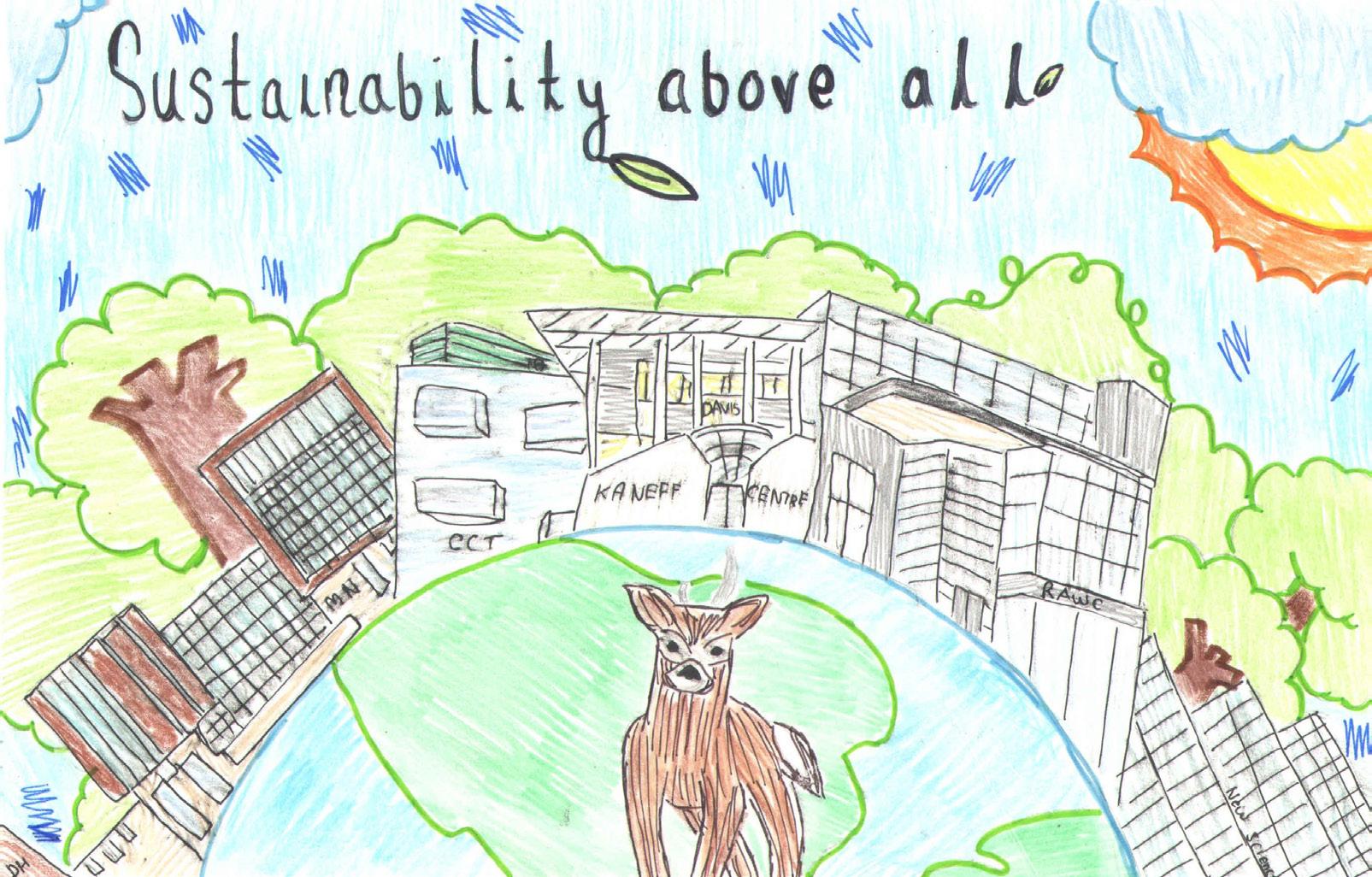
Those who were interested in learning about careers in sustainability had the opportunity to observe presentations and panels on Monday by professional leaders and innovators in the field of sustainability, including UTM alumni.
Illustration by April Roy
On Tuesday, there was an internship-related drop-in information session featuring Master of Science and Sustainability students, an art activism program, and a virtual event hosted by the Sustainability Office that facilitated discussions about carbon reduction on campus.
Additionally, there was a chance to do some art, plant potting, and terrarium building, as well as the opportunity to explore local food security solutions and practical at-home food waste strategies.
On Wednesday, students could take part in Fairtrade shopping in the Maanjiwe nendamowinan building for food, flowers, jewelry, soaps, candles, cookbooks, bedsheets, socks, hair accessories, bath towels, clothing and more. In the William G. Davis building, students dropped by to interact and relax with
Dino, the therapy dog.
Another campus sustainability tour was conducted as well as a workshop on slow fashion. The day wrapped up with an evening showing of The Lorax.
Thursday featured a Sustainability Fair run by the MSEC, where students, faculty, researchers, and industry professionals engaged with and discussed new ideas, best practices, and emerging sustainability practices. Also on Thursday was a sus-
tainability tour for students. Students also participated in free thrift shopping at the Student Centre, a UTMSU Sustainability Scavenger Hunt and a mapping activity facilitated by the U of T Mapping Club.
The week ended with the UTMSU Root and Renew event which was held at Hart House Farm and the Student Centre. Buses were available to take participants to the farm and back to campus afterward.
UTM historical department welcomes renowned professors for recent event
Samuel
News Editor
Titled “Classics and the World Today,” the event saw Professor Glenn Most and Professor Bettina Reitz-Joosse take the stage to give lectures on the use of building metaphors in antiquity.
On March 13, in the Kaneff Rotunda, the University of Toronto Mississauga (UTM) Department of Historical Studies hosted its annual “Classics and the World Today” (CaWT) event. The program was composed of two lectures that built on the event’s theme, “Building as Metaphor: Constructing Understanding in the Ancient and Modern World.”
Invited by the Department to give the studies were international Classics Professors Glenn Most and Bettina Reitz-Joosse.
Most is a professor at the University of Chicago and the Italian Scuola Normale Superiore di Pisa. He has taught at the Universities of Yale, Princeton, Michigan, Siena, Innsbruck, Heidel-
Dutch Royal Academy of Arts and Sciences and the Young Academy Groningen.
By the time the event started at around 5:15 p.m., the Kaneff Rotunda was packed with students from various disciplines. As light jazz music played in the background, Professors ReitzJoosse and Most took their places at the front of the room while UTM Classics Professor Andreas Bendlin opened the event and introduced the speakers.
Professor Most spoke first and began his lecture by offering various interpretations of the metaphor, including the views of Aristotle, I.A. Richards, and himself. The second part of Professor Most’s lecture explored various cosmogonic metaphors which were used in antiquity to conceive the creation of the world.
First, Professor Most referred to Hesiod’s Theogony to explore the analogy between the universe’s development and the construction of a house. Professor Most then discussed the idea of “separating and ordering” in Anaxagoras’ writing and the
cultural aspects of architectural metaphors to understand more about how Romans thought.
Professor Reitz-Joosse first explored the common analogy between speech and construction through Dionysius of Halicarnassus’ “On the Arrangement of Words,” Manilius’ Astronomica, Tacitus’ “Dialogue on Orators,” and Horace’s Odes. Professor Reitz-Joosse then stepped back to elaborate on her observations by claiming that metaphors can be used to cognitively manage the messiness of reality, as seen through how, despite construction obviously being very messy, it was treated as neat in the aforementioned texts.
Professor Reitz-Joosse ended her lecture by exploring the Roman conceptualization of ownership, which cast construction projects as being the creation of one person, while the many labourers who contributed were considered tools.
Immediately following the lecture and a brief Q&A, a reception was held in the Maanjiwe nendamowinan Grand Hall, where students enjoyed an assorted banquet and had the chance to interact with peers and faculty.
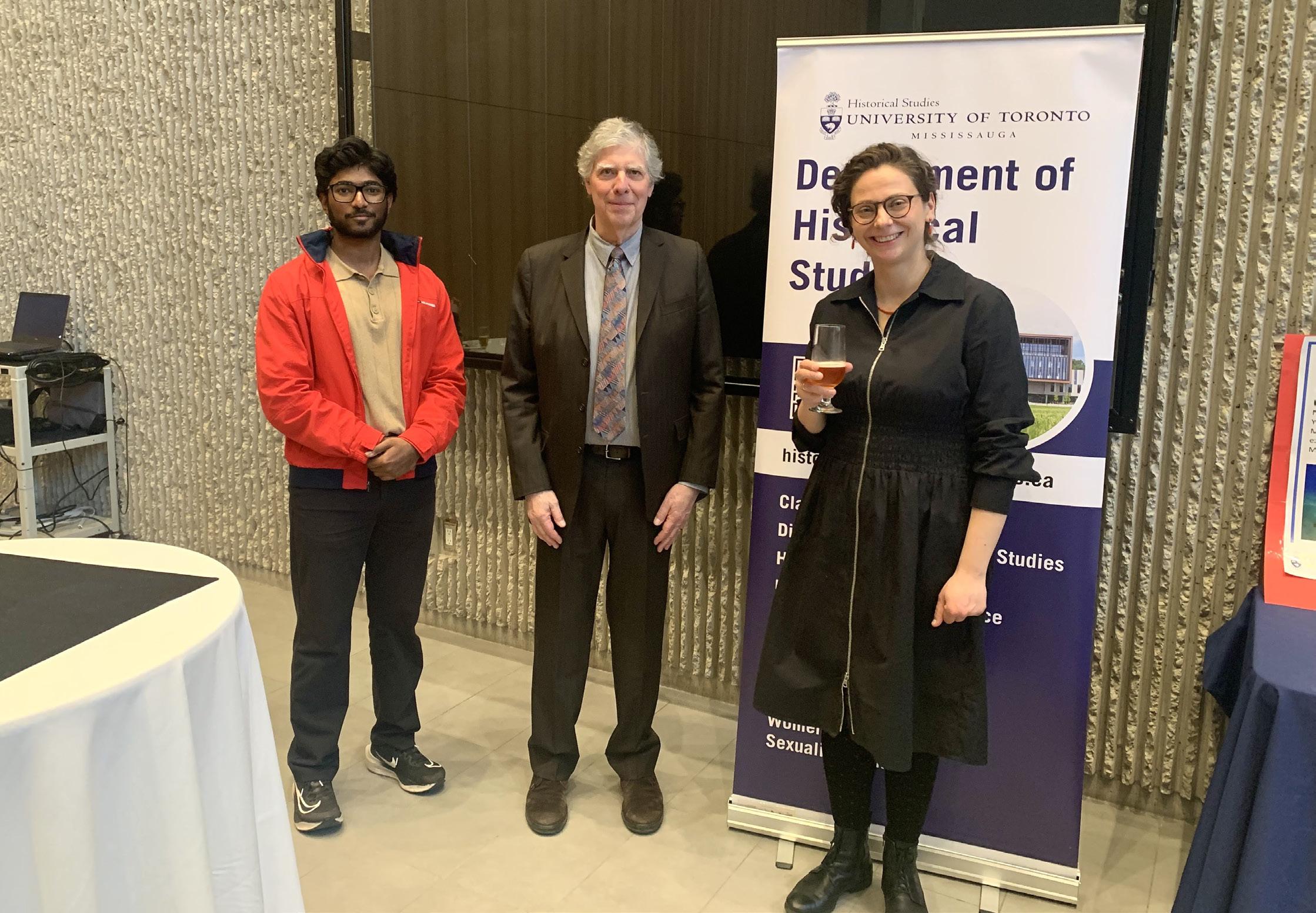
berg, and Paris and has published copious classics-based works and translations.
Reitz-Joosse is a professor at the University of Groningen in the Netherlands, where she was elected Lecturer of the Year in 2018. She holds degrees from the Universities of Oxford and Leiden and is a member of the De Jonge Akademie of the
Bible’s Genesis 1. Additionally, he referred to Genesis 2 to visit the “building of a garden.” Professor Most ended his lecture by pointing to the all-encompassing idea that the Earth is our home and encouraging the audience to act as its stewards.
Professor Reitz-Joosse then took to the podium to consider the
The Medium had the privilege of talking to both Professor Reitz-Joosse and Professor Most during and after the reception to glean their valuable insights.
In an email conversation after the event, Professor Most referred to classics as a “world which is both very distant from ours in time and yet closely linked with the present,” and noted that by studying classics, “we can learn not only about an ancient world but also about how the world has been understood over time by earlier generations and therefore, potentially by ourselves.”
In an in-person conversation, Professor Reitz-Joosse pointed to her work studying the ancient world today and specifically the modern usage of Latin, in contexts varying from politics to tattoos. “There’s this whole past of the language–thousands of years of history that you could marshal at the moment you use it.”
Professor Reitz Joose also shared her pleasure with the event’s filled-out audience. “I was very excited to see how many people were there and how many students were listening in this very engaged way...”
Finally, Professor Most stated that “UTM Classics has a bright future,” and seeing “so many engaged young students” and the chance “to speak with many of them was very heartening.”
Looking forward: What the incoming UTMSU executive team hopes to bring to UTM
Diana Fu Associate News Editor
Some key issues which the InnovateUTM team discussed included food affordability, transit, academic policy, and the student experience on campus.
After two weeks of intensive campaigning, the University of Toronto Mississauga (UTM) Students’ Union (UTMSU) Spring Election ended. InnovateUTM emerged as the victorious party, obtaining all five executive positions with a significant lead. The Medium spoke with the InnovateUTM team to learn more about their party, campaign, and goals for the upcoming school year.
When asked what their main priorities and goals are for the UTMSU, food, transit, and academic policies were the core issues InnovateUTM raised.
President-elect Andrew Park, a fourth-year student specializing in criminology, law and society, stated that these goals are based on the feedback from UTM students on what issues they face in university.
Park said that their “campaign has been carefully crafted to take these considerations and set actionable, measurable goals that we can advocate for during our term.” Their goals for the year regarding these issues are to improve the availability and quality of transit, create affordable food options for students, and make academic policy changes.
Other goals for the InnovateUTM team include creating more study and social spaces on campus for students, improving accessibility and inclusivity for students, supporting student
clubs, and increasing UTMSU’s transparency and engagement.
InnovateUTM also hopes to build off the initiatives of the preceding UTMSU executive team, such as those concerning extending the deadline for CR/NCR and transit advocacy, in addition to their activism on global issues. “[The] previous UTMSU executive team did well in establishing a platform we needed in order to talk about global issues,” said Miatah McCallum, a third-year philosophy and sociology student, and UTMSU’s next VP Equity. She stated that InnovateUTM plans to continue advocating for students whose families have been affected by these crises.
Rajas Dhamija, a second-year commerce and economics student who was elected as the next VP External, said that “increased communication with the student body” on UTMSU’s progress and decisions is something which could have been improved by the current executive team.
In terms of why they decided to participate, InnovateUTM was driven by numerous inspirations and motivations to run in the Spring Election.
VP Internal-elect Rui (Owen) Zhang, a second-year student specializing in digital enterprise management, pointed out the importance of “communication and structure” in a student union and how a lack of it can “create distance between the students and their union.” Zhang previously served as UTMSU’s VP Internal Associate, something which inspired him to “contribute meaningfully to the student body.”
McCallum, on the other hand, says that what inspired her to run in this election had to do with her experience at UTM as a queer woman of colour who is also an accessibility student.
“I wanted to be the representation that our campus was in need of… there are various areas on campus that need improvement.” According to McCallum, these include, a disconnect felt by queer students on campus, a lack of quality and consistent notes for students, and the support and community for racialized students.
Despite their impressive electoral victory of InnovateUTM, their campaign did face a few challenges, the most impactful of them being the illnesses faced by two of their team members during the campaign period. McCallum, who was one of the two, said that “the team pushed through,” and after their recovery, they “put in twice the effort to make up for the loss of campaign time we had.”
Moreover, engaging students and addressing misinformation was another challenge. Dhamija suggested that a disconnect between students and student governance is a cause of this, and because of it, InnovateUTM focused greatly on student engagement and open communication.
Regarding student leadership, Manaal Fatima, a third-year political science and criminology student and VP University Affairs-elect, described student governance “as the backbone of an engaged and secure student community.” Fatima also added that selecting a new executive team each year ensures responsive and accountable leadership.
“The students’ union is something bigger than just one person, team, or school; it is a movement that has been in motion for decades.” Park said, “It is a privilege and honour for us to be able to contribute to this movement and leave our mark in UTMSU history.”
UTM Advocacy and Litigation Team achieve podium finish in mock trial tournament

Aaron Calpito
Associate News Editor
Members of the UTM ALT competed against peers from schools across Ontario at the Ontario Mock Trial Alliance’s Winter Mock Trial Competition.
From March 8 to 9, teams from 16 universities across the province converged on downtown Toronto for the Ontario Mock Trial Alliance’s Winter Mock Trial Competition. The University of Toronto Mississauga’s Official Advocacy and Litigation Team (ALT) placed third overall, marking a big win for aspiring legal experts on campus.
The ALT congratulated its Mock Trial team in an Instagram post about the tournament, writing, “This achievement reflects our dedication to excellence in advocacy, and we couldn’t be prouder!”
EDITORIAL BOARD
Editor-in-Chief
Hannah Grace Wang editor@themedium.ca
Managing Editor Aya Yafaoui managing@themedium.ca
News
Samuel Kamalendran news@themedium.ca
Opinion
Mashiyat Ahmed opinion@themedium.ca
Features
Madhav Ajayamohan features@themedium.ca
A&E
Keira Johannson arts@themedium.ca
Sports
Joseph Falzata sports@themedium.ca
Photo & Design
Sara Li photos@themedium.ca
Hannah Grace Wang design@themedium.ca
Copy
May Alsaigh may@themedium.ca
Maja Tingchaleun maja@themedium.ca

TO CONTRIBUTE & CONNECT: themedium.ca/contact
@themediumUTM @themediumUTM @themediumUTM @themediumUTM
@themessageUTM @humansofUTM_
05 OPINION
Oh, the places you shouldn’t go!
Erin Sauvé Associate Opinion Editor
On selling out, settling for bullshit, and getting your share of the spoils.
Asgraduation season approaches, the university’s graduating class is faced with figuring out what to do with their newly minted diplomas. Those looking to join the workforce face a tough job market and the spectre of increasing unemployment rates. With job opportunities scarce, “honestly, at this point I’ll take anything” seems to be the go-to response when asked how the job search is going.
But should you take just anything?
‘Selling out’ when it comes to finding a job on the other side of graduation can mean different things. For some, it might means working in an industry that goes against your personal values and ethics. Last summer, I met a University of Toronto (U of T) Environmental Science alumni who went on to work for a gold mine who considered
jobs.

Many of the jobs that Graeber describes as ‘bullshit,’ based on worker testimonies, are jobs that typically require undergraduate degrees, such as administrators or marketers. These are precisely the jobs that some U of T graduates-to-be are furiously applying to.
But money and value don’t appear out of nowhere; they come from labour. Getting paid for doing pointless work ⎯ or, in the case of the mouse jigglers, not working ⎯ simply means that someone else is performing that labour. Moreover, this means that those who indirectly perform the labour that pads these so-called bullshit job paycheques are not fully compensated: this is exploitation.
The exploitation of people is, of course, the hallmark of capitalism. This exploitation often occurs overseas in the Global South, and the ‘spoils’ are funnelled over to the Global North. Working bullshit, sellout, or unethical jobs, although it is sometimes indirect, offers you the opportunity to claim “your share of the spoils”. In his book Blood In My Eye, American revolutionary George Jackson writes that “the

herself to be a sellout. For others, the term refers to following certain cliché paths that lead to money and prestige over genuine fulfilment. Today, these paths might look like working at a Big 4 consulting firm or doing software engineering at a tech company that somehow exploits workers in the Global South.
However, to be a sellout, one has to hold some latent disdain for the industry or the career path. This isn’t the case for many people. It’s not uncommon for people to pursue their degrees for the express purpose of landing a ethically dubious or even reprehensible job. For example, working at hedge funds and weapons manufacturing companies are the end goal for many finance and aerospace engineering students.
Most of the time, though, our graduates don’t end up in blatantly unethical industries. Many will end up in what anthropologist David Graeber called ‘bullshit jobs’. These are jobs that are “primarily or entirely made up of tasks that the person doing that job considers to be pointless, unnecessary, or even pernicious.” Mouse jigglers have gained attention for their role in helping remote workers pretend to work. By periodically moving the computer mouse, mouse jigglers make it look like remote workers are actively working even if they are away from their computer. While some people, including federal employees, have been caught using mouse jigglers, it’s likely that there are many other workers who are flying under the radar. If people can get away with not doing any work, then their jobs must be bullshit
breakdown of establishment-conditioning usually occurs at the university level,” where “students refuse to accept the lie that our exploitation of the world’s peoples is actually beneficial to them.”
Accepting your share of the spoils can ultimately align you with the interests of the ruling class as you see the benefits of exploiting the world’s peoples, something that Jackson argues is detrimental.
The point I’m trying to make is not that we should condemn those who choose to sell out or to work a bullshit job (although we should definitely condemn people enthusiastically going on to work at weapons companies!). Grocery prices and rents are rising to extortionate levels, and the income that these kinds of jobs offer can be lifechanging for many people. Additionally, your job doesn’t define your life, and I think that you can be a committed and engaged member of your community, even if your job doesn’t reflect the same values. I can also see how having these kinds of jobs can leave you with more time and energy to pursue fulfilling things outside of work.
But I also believe that, especially in a time when many people are applying to their new-grad jobs, it’s crucial for students to consider the ethical implications of these jobs. More importantly, I want students to at least attempt to find a job that serves their community. Or, at the very least, one that doesn’t hinge on the exploitation and misery of others.
Editorial: Goodbye, Volume 51!
Hannah Grace Wang Editor-in-Chief
A year to remember.
Aya Yafaoui Managing Editor
If there’s one thing I’ve learned as Editor-in-Chief of Volume 51 at The Medium, it’s how much teamwork matters in journalism. I am particularly proud of the entire Masthead for their amazing contributions and dedication to student journalism.
It’s truly inspiring to see all that we’ve overcome throughout this volume: we faced AI challenges in both writing and design, and later website security concerns, neither of which I could’ve ever foreseen happening. But we made it through these challenges, and we are stronger as a student paper because of it. This is what student journalism is all about, and I am honoured to have witnessed the entire UTM community’s hard work and passion.
Our paper has changed a lot since its inception, and I am grateful for the chance to nourish the legacy of The Medium. We are a testament to the fact that student voices matter and that student journalism matters—and will continue to matter. As the term comes to an end, I am left with pure awe. Awe at what we’ve accomplished, awe at what we’ve overcome, awe at our amazing masthead, staff writers, and contributors. I know Volume 52 will be in great hands, and it brings me great comfort to know that The Medium’s legacy will continue. Thank you for giving me the honour of serving as Editor-in-Chief
of Volume 51.
I want to say the sincerest thank you to Aya Yafaoui, our Managing Editor for Volume 51, all of our talented Masthead, our writers and contributors, and of course, our readers for your deepest support. Thank you for a year we’ll forever remember.
Yours truly,
Hannah Grace Wang
Well, it’s the end of another publishing year here at The Medium. We started the year wanting to reconnect with the student community at UTM, and I’m happy to say that our team has made great progress with involving writers and fostering a community within the paper. We are also proud of the stories we’ve covered this year, from across our five sections, our writers have touched on topics important to them and to our community.
As we finish out this year, we’ve faced some new challenges; namely, the use of AI and the threat that poses to the integrity of our work. We’ve been adamant that The Medium remains a space where original work is protected, both in writing and illustration. The integrity of our journalism and platform require us to ensure that the words and images we publish are the true product of our students and university community. And so, as we move forward, we will continue to uphold that standard and strive to always be a space for originality and integrity.
Of course, our paper has also had to adapt to the financial pressures that are facing every student paper, and the wider journalism industry. To accommodate our budget and the
rising costs of printing, we’ve had to scale back the number of issues we published, desperately trying to fit in as much as we could. In the future, we may continue to see that evolve with more online issues. For now, though, we are set on trying to keep The Medium as it’s always been: bright, colourful, and informative.
As Volume 51’s managing editor, I’ve had the pleasure of working with our masthead to fill the paper with engaging and thoughtful articles. I’ve been at The Medium for almost six years, and to see how the paper has grown after the trials and tribulations of the COVID-19 pandemic has been heartwarming. This paper only exists because of students who care about it. And to see more people contribute to this paper and uphold its mission brings me hope that student journalism will continue to survive these difficult times.
So, as we close out this year, I want to say thank you. Thank you to the students who read our paper. Thank you to the writers who fill it with their words and stories. Thank you to our editors who grow and cultivate our writers and community. Thank you to our masthead for keeping the ship running. And thank you to all the members that have shaped our paper to what it is today. As my mentors Ali Taha and Paula Cho said in their farewell address for Volume 47, “We’re standing on the shoulders of giants.” May we remember those who came before and hold up the brave journalists who will come after.
Sincerely,
Aya Yafaoui, Managing Editor for Volume 51
To live in perpetual explanation
Jia Bawa Associate Opinion Editor
Existing as a bisexual woman means being subjected to constant questioning, sexualization, and plain misunderstanding.
Even in 2025, being straight is the default. LGBTQ+ people are still scared to grapple with the complexities of their identity, the implications, and how coming out will affect their lives in unforeseen and complicated ways. Having to deal with the fact that you might have feelings for the same gender is already hard enough, but add on top of that the simultaneous attraction to the opposite gender? Well, you’re in for a treat.
Since the beginning of time, women’s sexuality has not been their own, but rather, a man’s possession. This is especially the case for bisexual women. We are constantly fetishized, even more than lesbians, simply because we like both men and women. To men, we are the ultimate fantasy. Since, 2015, ‘Lesbian’ has been the most searched for category on Pornhub. More often than not, being a bisexual woman in a relationship with a man is more about being his trophy than his partner, the object of his warped sexual fascination than a lover. You are a
trophy, a challenge, or something to be “fixed”, you don’t actually have non-platonic feelings for women, you are just looking to experiment. Sleeping with a bisexual woman makes certain men feel like they’ve “cheated the system”.
this dynamic, bisexual woman are seen as a “racy add-on.” Boundaries are rarely clearly established, and our emotional and physical safety is blatantly violated. We are merely a tool to fix or further develop heterosexual relationships, and never enough on our own.
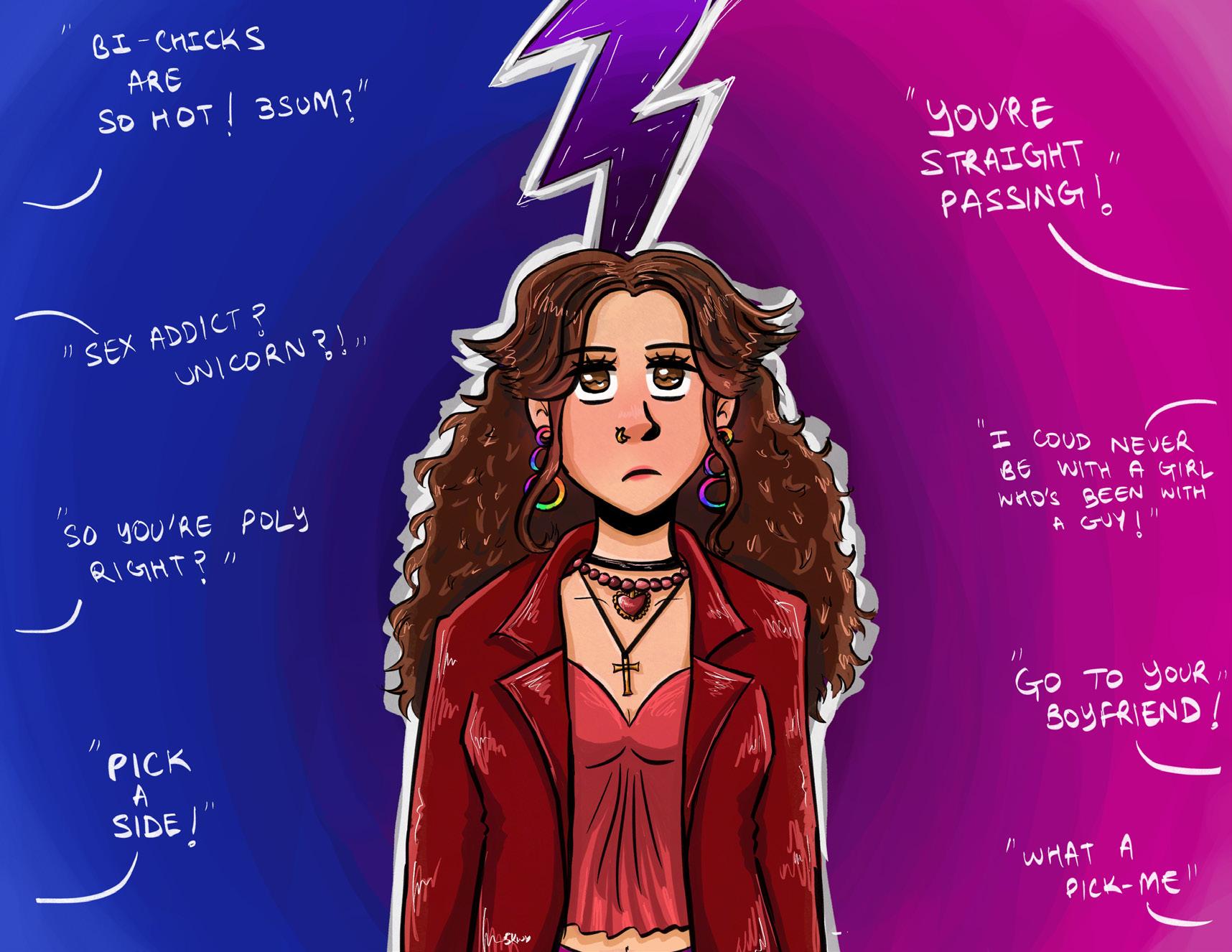
When bisexuality is hypersexualized Often, we are the target of “unicorn hunting”, which is when bisexual women are approached by heterosexual couples who are “looking for a third” or want to “spice things up in the bedroom.” Some couples are upfront about their intensions, but most use deception and catfishing to lure bi-women. In
And if you, as a bi woman, are in a relationship with a man, be prepared for the covert, if not constant invalidation of your identity. Men are usually thrilled at the revelation of your bisexuality, because for them, that signals threesomes galore! They make it clear they don’t care if you cheat on them with a woman, because being with a woman isn’t valid enough to constitute “real cheating.” Your bisexuality is hypersexualized, and men forget that being bisexual means that you can love women, not just be sexually attracted to them. This sort of pervasive sexualization of your experiences is a result of women’s sexuality existing solely for the male gaze. Sadly, being subjected to this is one of the reasons why bisexual women are often victims of “compulsory heterosexuality” and internalized biphobia.
For instance, as a teenager, I used to think that although I was bisexual, I could never “truly” be with a woman, chalking it up to an itch I needed to scratch that I would probably get the chance to explore in university. I thought that once university was over, I was to lock this part of me in the depths of my mind and throw away the key. At least 3 years of my life were spent in a constant state of self-doubt: what if this was all a show, to be “cool” or “trendy.” Were the Republican’s right? Fast forward to my first year of university when I had my first kiss with a woman, and my anxiety and self-doubt dissipated. That encounter, coupled with the big fat crush I had on the object of my desires, helped me quietly accept my bisexuality; even when others didn’t.
Bi-erasure in the queer community
Up until now, I have only talked about the role of straight men in bisexual fetishization and erasure. Would it surprise you to know, that we aren’t exactly accepted by the queer community either? Countless queer women have stated they “don’t date bisexuals,” calling it “too much drama”, and the age-old, “what if she leaves me for a man”, or “it is insulting if she dates a man after dating me”. As a result, it is quite difficult for openly bisexual women to date other women, as we’re often made to be the victim of ghosting. And as such, we aren’t considered to be “dating material.” Too straight to be gay, but too gay to be straight. What about your queer friends? If they are monosexual, chances are, they too view your identity as something unserious: an experimental phase. Many will take quick jabs at you, they will refer to bisexuality as being a gateway: if you’re a bi man, you’re basically “too scared to come out of the closet,” and if you’re a bi woman, you’re “just straight, with a desire for experimentation.”
A great example of biphobia within the queer community was shown in the Freeform series, The Bold Type. Kat Edison, one of the main characters, has always thought of herself as straight, until she meets Adena, a lesbian artist, and falls in love with her. At this point, Kat identifies as a lesbian. After they break up, however, Kat finds herself unexpectedly engaging in a fling with a man, which cements her bisexuality. Adena and
Kat are still friendly, however, upon finding out that Kat is now “back with a man”, she displays aggression and defensiveness, trying to oust her from spaces for queer women, claiming that it would make everyone uncomfortable, and that such behaviour is discouraged. Similarly, in pride parades for example, if a bi woman happens to be present with her male partner, she is called “straight” and told that pride isn’t for her.
On the other hand, if a bi woman’s current partner is another woman, she is referred to as a lesbian, her bisexuality once again erased. It appears that, regardless of whether we date a man or a woman, our identity will be invalidated, often times by the very communities that are supposed to support and represent us. Our ability to look past gender, and love people for who they are, is not celebrated, but instead twisted into something ugly. We are constantly chastised for not “picking a side,” and thought of as being “greedy, slutty bisexuals.”
People have an inherent desire to be accepted, but as a bi women, when we feel unwanted even in queer circles, it can lead to distress and loneliness, dredging up the feeling of never belonging anywhere we go, forever stuck in limbo.
Forever in limbo
According to The Open University’s Bisexuality Report, pre-
To slop or not to slop
Is there a place and time for slop media?
As a chronically online generation, experiencing the overwhelming rise of “slop media” — which is normally defined as AI-generated content, but also encompasses mediocre brain-rot videos, articles, and even opinions that reflect such content. But despite the ethical qualms of AI and the rise of anti-intellectualism, is there a place and time for slop media?
The Medium asked three students to reflect on this question. And no matter how anti-slop you may be, you’ll probably end up doom-scrolling on TikTok for 45 minutes after reading this article (if your attention span allows it).
Erin: What is slop media distracting us from?
I find the rise of slop media quite sad! There are so many wonderful books, movies, and other forms of media that already exist, and I think slop media as it stands today can prevent us from experiencing them fully. I certainly often find myself scrolling on Twitter instead of reading my copy of Ulysses.
I don’t just think that slop media robs us of time. I think it can also affect our ability to engage with “non-slop” media. As Martin Scorcese explains, franchise films like Marvel movies crowd our commercial cinema, pushing out movies that might offer us unexpected experiences. Also, ChatGPT is now able to better mimic the style of Studio Ghibli. I think that can work to depoliticize that studio’s films and to reduce them to just an “aesthetic.”
Engaging with meaningful, ambitious, and transformative works of art can be difficult and even unpleasant. Meanwhile, Marvel movies are perpetually in theatres, the internet is flooded with AI-generated content and images, and every app has some sort of short-form video feature. While I’m not surprised that slop is so popular, I think it’s a shame that it prevents us from experiencing more meaningful works of art.
Massimo: A slippery slope
dicted rates of depression, anxiety, self-harm, and suicide are higher among bisexuals, as compared to other sexual minority reports. Stonewall Charity’s research also reports that 27% of bisexual women and 18% of bisexual men have been victims of biphobia from within the queer community. Furthermore, Stonewall claims that a third of bisexual people (32%) don’t share their sexuality with anyone in their family, in contrast with 8% of lesbians and gay men, indicating the culture of hesitancy and concealment that bi-people must crushingly navigate.
Therefore, the fetishization and erasure of bisexual women are not just uncomfortable truths, but insidious forms of invalidation that have tangible psychological and emotional consequences. Existing as a bisexual woman means being subjected to constant questioning, sexualization, and plain misunderstanding; by straight men, by queer communities, and even by oneself through the internalization of our environment. It’s to live in a state of perpetual explanation, to feel invisible unless you’re catering to someone else’s gaze or fulfilling someone else’s fantasy. But bisexuality is not a phase, not a performance, and certainly not a punchline. It is a valid, complex, and deeply personal identity that deserves to be seen and respected in all its glory.
As someone who uses social media sites such as YouTube quite frequently, I’ve come to notice that media slop is only becoming more common. If you use social media there is a good chance you’ve seen AI generated art, reels, and replicas of other creators, but I’ve found that a lot of media slop doesn’t even use AI. Most videos on my homepage are simply just effortless content that revolves around regurgitating popular takes, trends, and drama to gain more views on the algorithm, while limiting the amount of uniqueness and creativity.
But sometimes, there could be a catch; I believe that some creators tend to resort to reactionary content, drama commentary, and reporting about new trends simply so they can fund the larger creative projects that they actually care about.w Because a lot of creators rely on posting content for a living, one of the easiest options to make more money is to make what sells, even if it means resorting to producing slop me-
dia to fund resources to make the content that one is actually passionate about. But I think we should question a world that drives creators to the slop industry, especially at the expense of creative authenticity.
Callie: slop media is a necessary evil!
In my opinion, slop media is a necessary evil. Similarly to functionalism, for a system to function, there needs to be negatives to balance out the positives. Of course, slop media is not Pulitzer Prize-winning quality content, but it is still consumable. Not everything needs to be ‘intellectual’ or serious; sometimes you just want to shut off your critical thinking brain and rot. Obviously, it’s healthy to consume ‘proper’ media from time to time, and watch out for AI misinformation slop, but at the end of an exhausting day, there’s nothing wrong with plopping down on your bed and scrolling on TikTok for a daily dopamine hit. Which is exactly what you’ll do after reading this article!
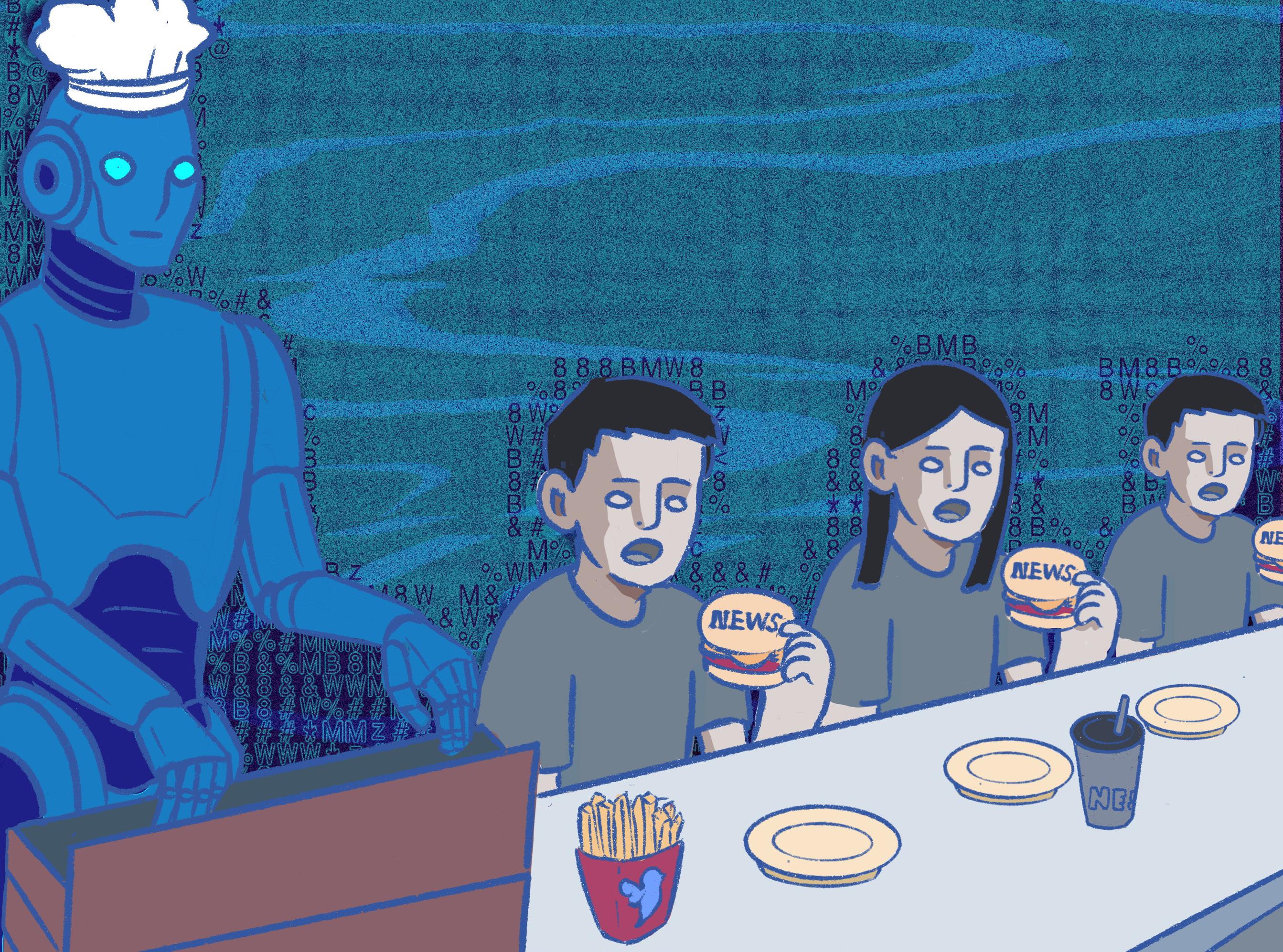
08 features
Going beyond chalk-and-talk
Erin Sauvé Associate Opinion Editor
Exploring the difference between active learning and traditional lecturing and how it impacts student learning.
When you picture a university-level math class, you might imagine something like a scene out of Good Will Hunting—a big blackboard with nebulous math scribbled all over it and a lecturer planted in front.
However, University of Toronto (U of T) Mississauga (UTM) students are finding themselves in math courses that break from the traditional ‘chalk-and-talk’ style of teaching. Non-traditional pedagogies such as active and inquiry-based learning are student-centred ways of teaching.
Rather than treating classes as a time for one-way knowledge transfer from professors to students, these non-traditional pedagogies prioritize student engagement and the learning process. Instead of spending the bulk of lecture time listening to the professor and taking notes, students might arrive at class having read some of the lecture material and are encouraged to solve and explore problems during class, often with their peers.
teach.”
While practicing math occurs mainly outside of the classroom under traditional pedagogies, active learning enables professors to incorporate content inside the classroom. Assistant Professor Micheal Pawliuk, also a math teaching stream instructor, explained that learning math is “more than just facts and techniques,” and that “it’s about perspective and practicing.”
Classes that de-emphasize pure lecture and incorporate more practice and exploration can better emulate and support the learning process. Professor Thind compares learning math to learning an instrument—while listening to an instructor can be helpful, it is impossible to learn to play the instrument with-
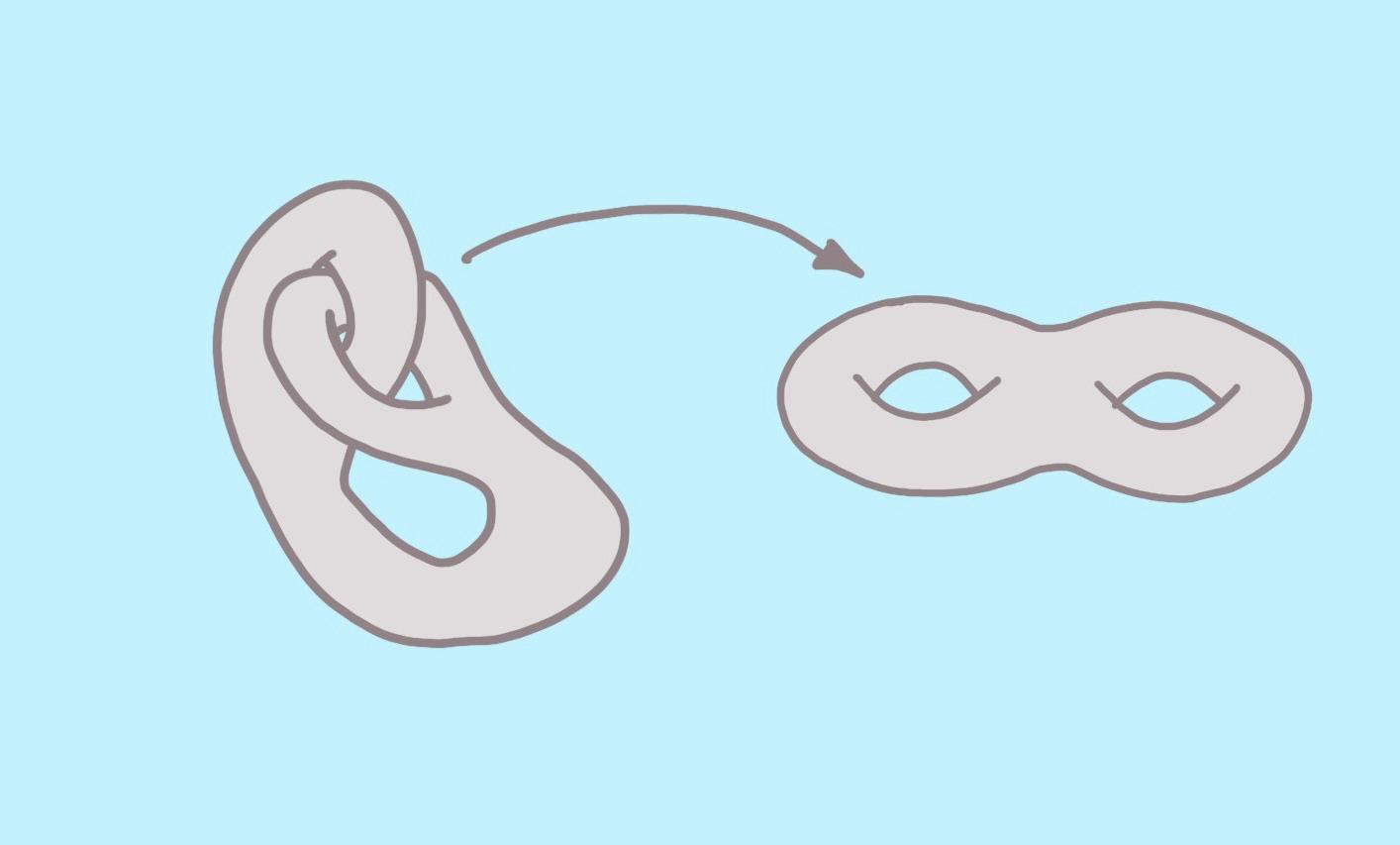
out practicing. Similarly, practice is a core tenet of learning math that cannot be divorced from the learning process.
UTM was the first campus of U of T to pilot active learning, and it has since been widely embraced across all three campuses. Many students’ first experience with university-level math is now in an active learning environment.
This departure from traditional lecture styles at UTM reflects the research that points to traditional lectures being an ineffective teaching method. According to a PNAS research article, students in classes with traditional lecturing were 1.5 times more likely to fail than students who were in active learning classes.
According to Professor Jaimal Thind, a teaching-steam math assistant professor at UTM, “Getting up and talking for two hours and making everybody listen is not the best way to
Unfortunately, math maintains a bad reputation for many people. Whether it stems from the canonical experience of crying over long division as a child or feelings of inadequacy in the subject, many people approach math with fear and repulsion, especially in the context of tests. This is part of a phenomenon known as ‘math anxiety.’
Some non-traditional teaching methods and course structures might alleviate some math anxiety. Courses that use masterybased grading, where students have multiple attempts at term tests and can master topics at their own pace can reduce the perception that tests are threats.
In an even more radical move, some courses, such as MAT344 (Introduction to Combinatorics) have done away with assignments and timed assessments entirely, opting instead to grade

Editor | Madhav Ajayamohan features@themedium.ca
portfolios of students’ work over the semester.
Moreover, in many student-centred pedagogies, students work through problems with their peers during class. Thind describes the experience of math as “being stuck most of the time and coming to terms with it,”—a foreign and disheartening feeling to a student who is new to math. Working on problems in groups “helps [students] feel less isolated,” Thind explained. “There’s something reassuring about ‘I’m stuck, but so is half the class.’”
Although the evidence suggests that these non-traditional pedagogies can improve students’ performance, students have mixed feelings about them. Rakshaan Koodoruth, a fourthyear student completing a double major in mathematical sciences and economics, shared that “for more challenging concepts, I would much rather have active learning.”
However, Adil Billah, a third-year student double majoring in mathematical sciences and physics, prefers the opposite and instead, “normal lecture styles.” He explained that he found it more helpful and rewarding to see “long derivations instead of just doing exercises yourself.”
While there has been a major shift towards active learning in UTM math classes, it has its weaknesses. Professor Pawliuk explained that active learning courses can involve many microcomponents, including readings, weekly quizzes, and assignments. Pawliuk admitted that this approach “doesn’t always set things up well for sitting with big ideas or exploring bigger topics.”
The advent of ChatGPT and generative AI is also changing the educational landscape. Plagiarism is becoming increasingly difficult to detect in math assignments, and instructors are forced to adapt. While there had previously been a push to have assignments and non-timed assessments make up more of the course grade compared to tests, Professor Thind noted that this move is quickly being reversed in some classes.
As the educational environment and research on math pedagogies continue to evolve, so will the math courses at UTM. “We want to capture [students’] sparks,” Professor Pawliuk said, “and help them ignite.”
Bonus! A bit of math for you from Professor Thind. In the image above, see if you can transform the surface on the left to the one on the right by stretching, shrinking, pulling, and pushing the surface. You CANNOT tear, cut, or rip the surface.
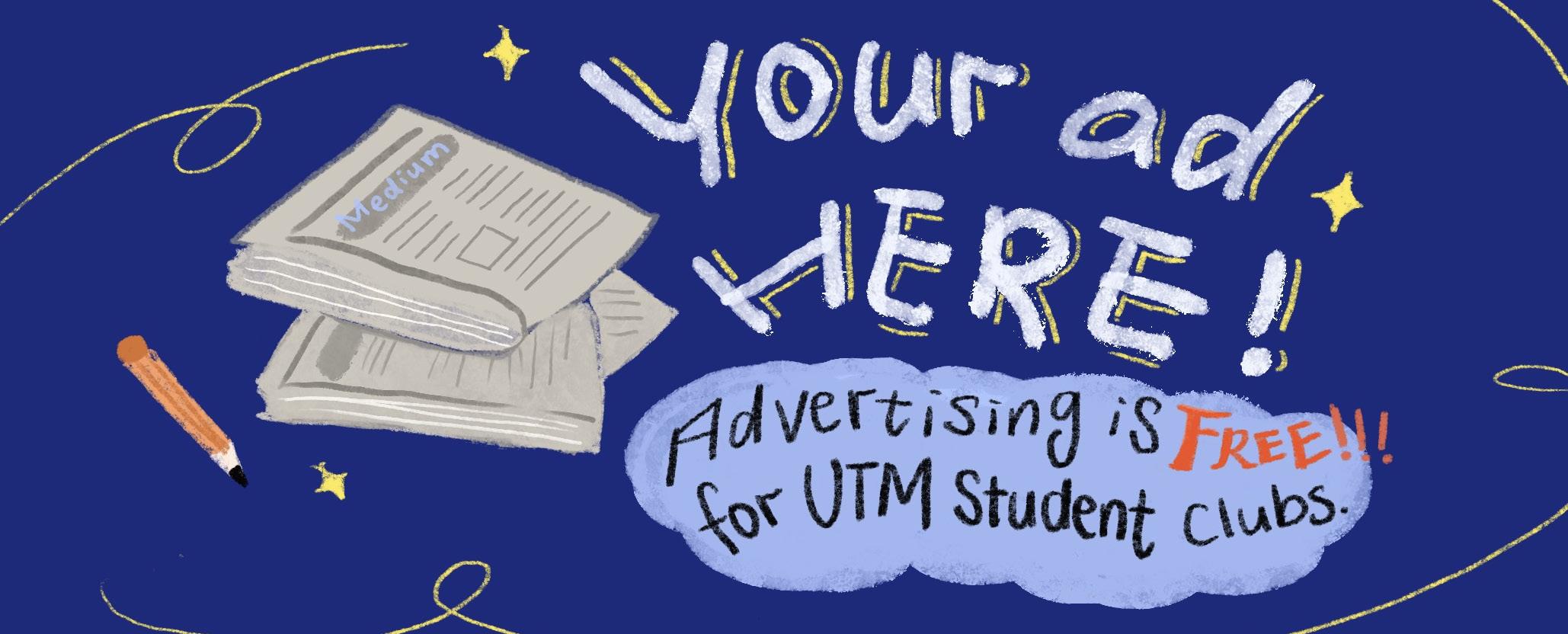
A final sign-off and a heartfelt “See you next year!”
Section Editors
The editors of The Medium say goodbye and welcome a brand new chapter.
News
It’s been a thrilling and memorable year as News Editor! From the first pitch email I sent in August to the final email last week, working with you all has been nothing but a pleasure! A special, heartfelt thank you to every associate editor and writer who contributed their time and effort to informing our school community of everything from University of Toronto Mississauga (UTM) events to human rights crises. To our readers, I hope that the news section brings you closer to our school community and ignites a passion for our collective success, just like it did for me.
To the incoming masthead and the readers of the next volume, keep the flame of The Medium burning bright! Our publication not only has an extraordinary history, it has an awesome potential that can only be realized through your ingenuity and passion. My hope is for that vision to be achieved and made into a reality. Best of luck!
– Samuel Kamelendran, News Editor (Volume 51)
Opinion
Even though being Opinion Editor has given me back pain and eye strains, I’ve really enjoyed it! Apart from freshening up my resume, this publishing year’s been incredibly valuable for a few reasons:
Firstly, I’ve made some new friends: shout-out to Samuel, our News Editor, for his unwavering professionalism and Sara, our Photos Editor, for her warm smiles and artistic vision all throughout the year. And most importantly, shoutout to anyone on the Volume 51 Opinion group chat for being such passionate writers, but also for being my friends.
Never stop writing!
– Mashiyat Ahmed, Opinion Editor (Volume 51)
Features
Before I became Features Editor, I loved The Medium because it was a space where I could write my thoughts and ideas down. After becoming Features editor and reading and editing the work of all the writers, it made me love The Medium even more. Every issue presented teaches the UTM campus and the world around me in new ways. I loved the unique voices every writer had and the new perspectives The Medium had to offer each time I read.
Thank you, my dear writers, for being such amazing writers, and making my time as Features Editor worthwhile. You have always amazed me with your thoughts and inspired me to move forward.
– Madhav Ajayamohan, Features Editor (Volume 51)
For the last time, happy writing!
Sports
What an amazing year for UTM Sports! The four tri-campus championships won by our Eagles (men’s outdoor and indoor soccer, women’s indoor soccer, women’s flag football) are the most in school history. The pair of Ontario Collegiate Recreation (men’s and women’s basketball) just adds to the sweetness. The best part is that these stories were all featured in our campus paper for every student to read!
To the athletes who covered these games—thank you. You’ve not only fostered sports culture on campus, but also a school legacy. Your stories are forever cemented in The Medium’s archives. I hope you all come back to reminisce one day.
To my other writers—thank you. A section only featuring our tri-campus teams would fail to show our much larger sports and health community. Your articles showcased how vibrant UTM’s sports and health scene truly is.
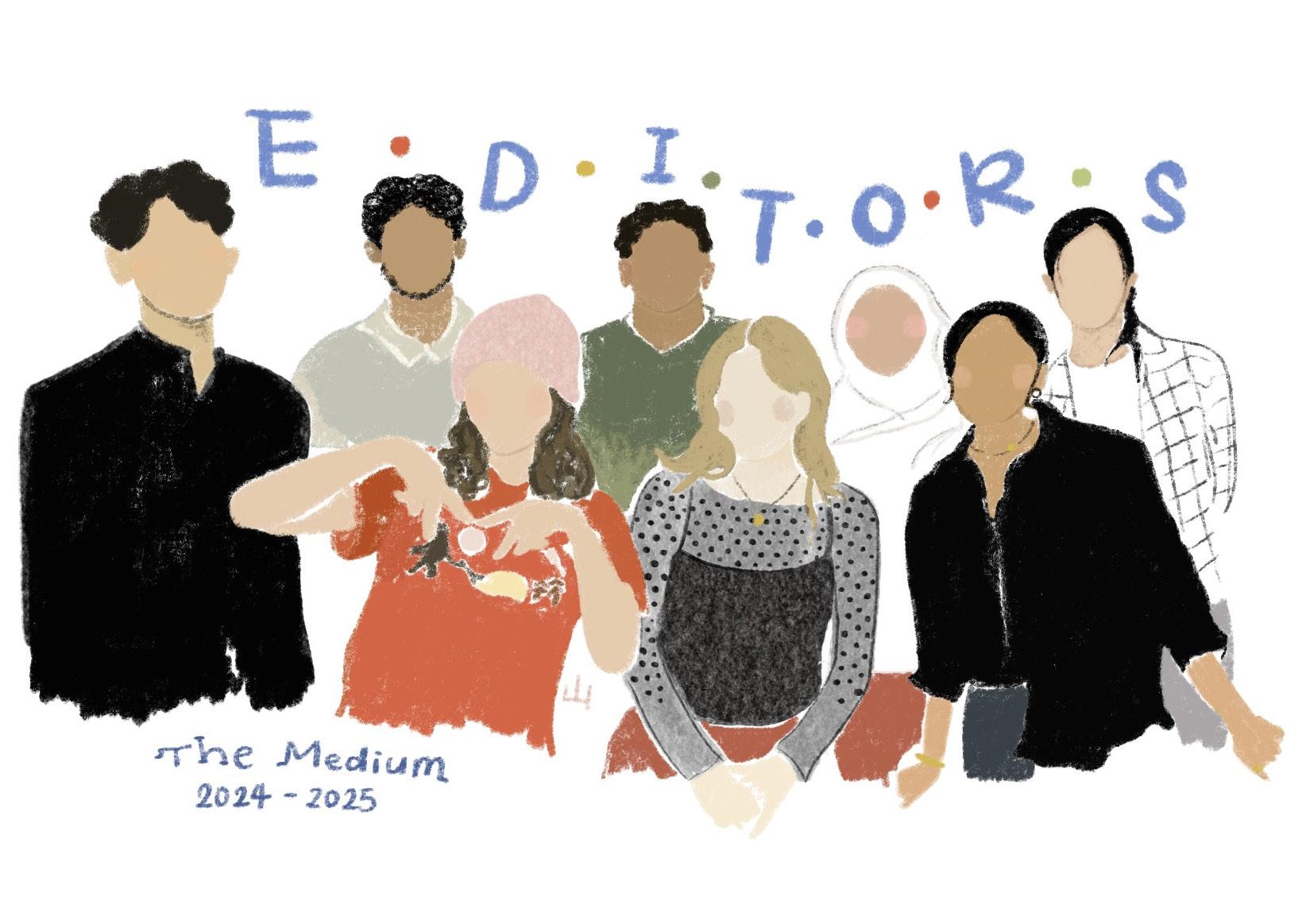
by Sara Li
And to our readers—thank you most of all. A newspaper without readers would just be a journal. I hope Sports and Health has kept everyone entertained this year.
– Joseph Falzata, Sports Editor (V51)
Photos
Secondly, this year taught me that people actually read The Medium. I’ve seen issues tucked under a professor’s arm, in a student’s bag, and even on tables at Maanjiwe nendamowinan. This year also taught me The Medium needs to revamp our social media game so that we can reach more students, enhance our accessibility, and better represent our community.
Lastly, I’ve learned (or re-learned) that independent journalism is not dead in a world of recycled headlines, shallow opinions, and incentivized narratives that have nothing to do with truth, independent and student journalism has only grown stronger. And anyone that has contributed to our paper has played a part in building that grassroots strength. As young writers, if we forget that, we lose. And they win.
Thank you all for trusting me with your words and thoughts.
Arts and Entertainment
When I first began my journey at The Medium as a Staff Writer for volume 50, I found a sense of comfort in our small but mighty Arts and Entertainment section. My goal as editor this year was to create a space where our writers and readers alike would find a home in the words of our student-run newspaper, shed light on UTM’s artist community, and explore how media impacts the human experience.
I’d like to give a quick shout-out to our Associate Arts and Entertainment Editors, Zainab Hassan and Skyler Piskoroski, whose ideas and words were nothing short of extraordinary, and to our Theatre Erindale Correspondent, Ramiya Sureshkumar, who ignited our pages with the most thoughtful reviews of UTM’s very own theatre department.
And, of course, a big thank you to every volunteer writer and designer who contributed even a small fraction to our section this year. I hope that you feel at home through our pages and that you continue to share your brilliance, creativity, and ideas with the world.
As the photo editor, I love receiving emails on Saturdays and being the first to see all the beautiful illustrations and photos for the upcoming issues. Then on Monday, when I visited The Medium website, I marvel at how vibrantly the front page has been decorated with the new issue’s graphics! Every time, I still feel that sense of excitement, even though I’ve already seen all the designs while collecting them.
That’s to say, I couldn’t be more proud and grateful to our talented and hardworking volunteers, staff illustrators, and associate design editors this year. You are all amazing artists whose work deserves to be seen and celebrated! I’m so glad you’ve found The Medium to be a platform to showcase your artistic talents.
A heartfelt thank you for making our newspaper so beautiful this year. I wish you all the very best, and I can’t wait to see more of your wonderful work on the Medium next year!
– Sara Li, Photos Editor (Volume 51)
10 Arts
The irony in fans’ excitement over Sunrise on the Reaping What it means to “Run Like a Girl”
Laiba Haque Contributor
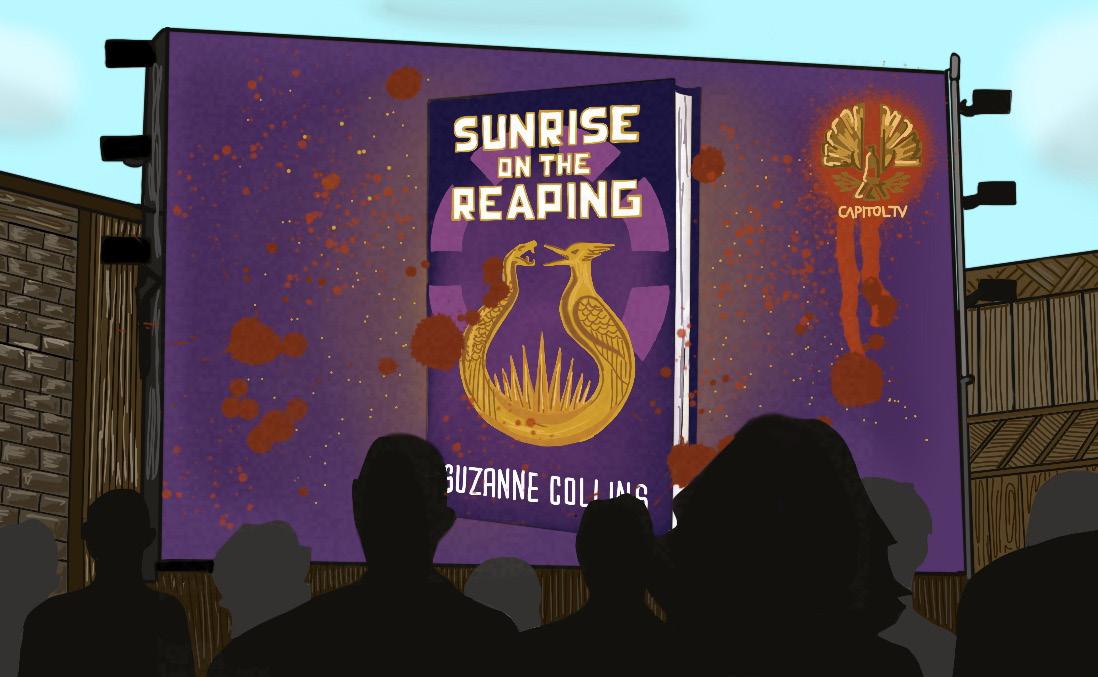
Emma Catarino Staff Writer
Fans of The Hunger Games seem just as excited to read Suzanne Collins’ latest novel about child murders and trauma as the members of the Capitol are to watch the Games themselves.
The Hunger Games by Suzanne Collins was first released in 2008. Since then, four more books have been added to the series, the latest of which is the long-awaited Sunrise on the Reaping, released on March 18, 2025.
Sunrise on the Reaping follows 16-year-old Haymitch Abernathy as he survives the 50th Hunger Games, one which was especially despicable because twice as many children were placed in the arena. The novel follows Haymitch as he transforms from a young teenager doing what he can to support his family, to a drunk, detached, traumatized adult man who dreads every Reaping and puts little effort into being a mentor, as he knows the outcome every year will be another two dead children that he failed to save.
In the 17 years since The Hunger Games was first released, the media has commonly misunderstood the point of the original story. The marketing of the movies and subsequent books revolved around a “love triangle” between the characters Katniss, Peeta, and Gale. Although this take on the books is widely popular, those who’ve read the novel know that while romantic moments did take place between Katniss and both men, Katniss was overall too focused on survival to care about dating. Watering the plot down to a simple love triangle completely ignores the intricate dystopian conflicts and commentary on society. This ignorance of the original themes was further seen when the movie A Ballad of Snakes and Songbirds, was released. Coriolanus Snow, the man responsible for the yearly atrocity, is portrayed as a handsome man in his youth. His beauty swayed many fans of the series into liking him and forgetting his actions in the original trilogy that they previously detested him for.
Fans were excited for Sunrise on the Reaping. As someone who’s loved this series since the age of 10, I’ve been waiting almost a decade for its release. However, very few are grasping the irony in the excitement around the novel. The entire narrative premise of the series is that the Capitol enjoys the grotesque coverage of children murdering children. The game makers take delight in creating arenas specifically designed to make these deaths more dramatic to increase viewership. We witness this grotesqueness and yet here we are, the audience, eagerly awaiting more content for our own enjoyment. What makes us any different from the Capitol?
The irony is made even more ridiculous when you find out that China’s Lionsgate theme park, includes different dystopian-themed attractions and rides like Twilight, Divergent, and yes, The Hunger Games. This rings eerily similar to a line in the original novel, where Katniss states that previously used arenas later become museums, where Capitol children can visit and reenact the deaths of older games. Not to mention the TikTok video that James Charles posted where he sat in first class on an airplane sipping champagne as he read the new book while the Capitol theme song music played. If that doesn’t scream out-of-touch Capitol mentality, I don’t know what does.

Exploring themes of feminine rage and resistance in Paris Paloma’s viral song, “Labour.”
“She’d do what you taught her / She’d meet the same cruel fate / So now I’ve gotta run, so I can undo this mistake / At least I’ve gotta try”- Paris Paloma
On March 24, 2023, 25-year-old English singer-songwriter Paris Paloma released a song called “Labour” (stylized “labour”), which became the first of its kind to encapsulate the expectations of what it means to be a woman, clarifying the newfound phrase known as “female rage.” Female rage can be defined as the “inherited response to struggles, oppressions, and wrongdoings that women have been subjected to.” This broadly discusses the ways that women are expected to be silent and calm even while being disrespected. The moment they lash out they are considered “crazy” by societal standards. The same cannot be said for men, who can act out due to the belief that men have a biological predisposition to anger.”
“Who fetches the water from the rocky mountain spring / And walk back down again to feel your words / And their sharp sting?”
Paloma created a spark in feminist history, especially after her US debut premiering “labour” on The Late Show with Stephen Colbert. The bridge spoke to women globally, containing a simple yet hard-hitting message that women can be seen as tools for reproduction with zero autonomy of their own.
“All day, every day, therapist, mother, maid / Nymph, then a virgin, nurse, then a servant / … / 24/7 baby machine / So he can live out his picket-fence dreams.”
Ultimately, Paloma encourages the breaking of patriarchal patterns that have been around for generations, to let women live how they want to and relay perseverance in those that suggest otherwise. The blunt lyricism, that has now reached over 260 million streams on Spotify, links together women’s sacrifices.
“labour” has since resurfaced in popularity on TikTok. The latest trend clips a series of montages from various movies and TV shows containing female characters escaping dangerous situations with a tagline titled, “Run like a girl.” The sentence historically has been considered a way to insult others, associating the stereotypes of women having less athletic abilities than men.
Fortunately, the trend reinvented the phrase with the impact of adrenaline-filled survival, opening new conversations about what it means to be a woman. The trend has even invoked others to share real-life experiences that detail events where women had fearful encounters and had to resort to running for their lives to escape abuse or assault. Other videos involved creators showing their pets, be it cats or dogs, on camera with captions explaining how protective and actionoriented their furry companions can become in high-stress scenarios.
Overall, I would describe the song as a revolutionary form of entertainment that clarified the meaning of the modern phrase “female rage,” allowed women who endured oppressive experiences to be recognized, and highlighted the importance of unity within communities. This is all in hopes of creating a better and more definitive future for the generations of women that precede us and to continue necessary discussions of womanhood and the fight for earned equal treatment.
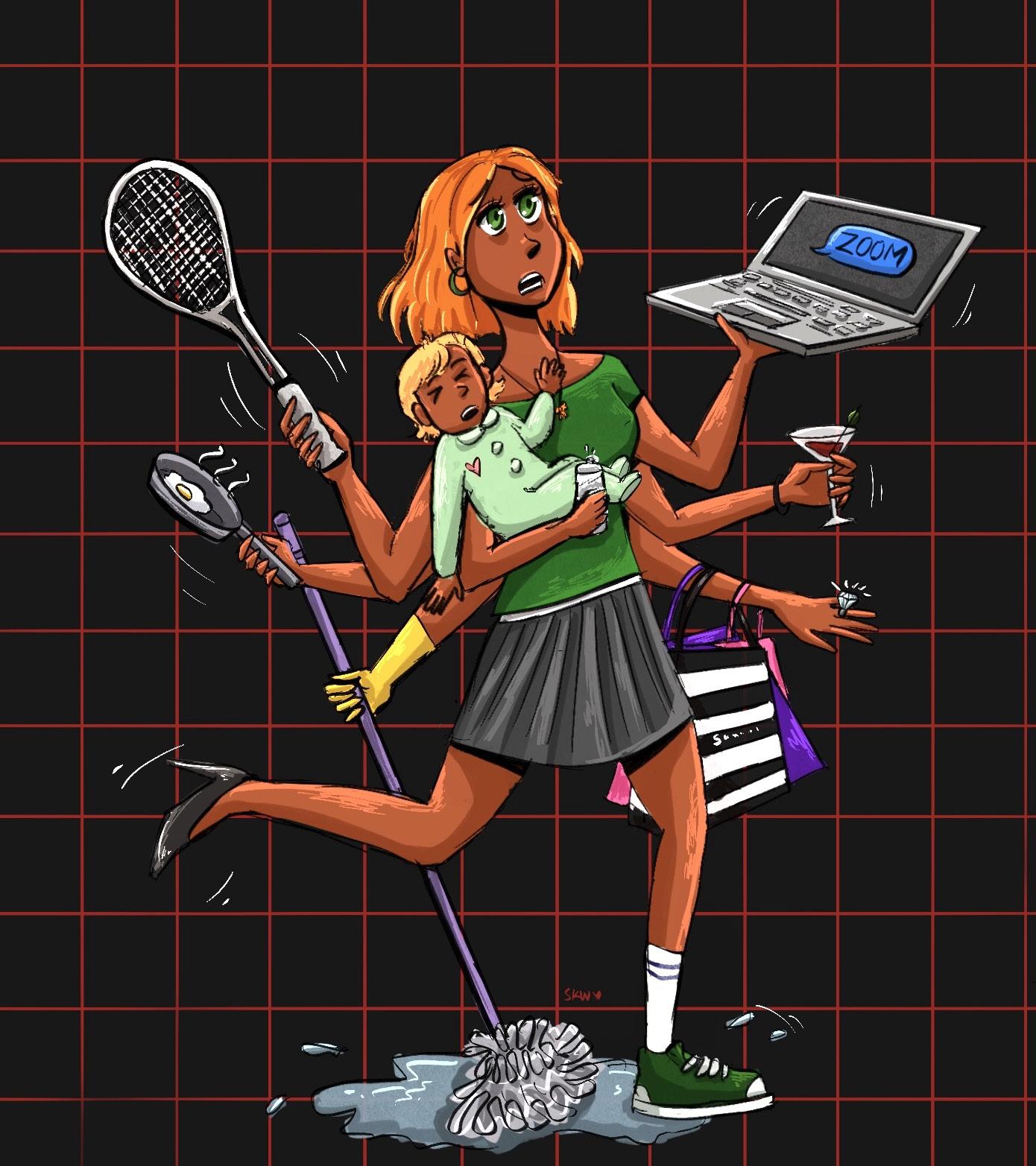
Call it cliché but I believe everyone is a true artist
As an artist myself, I’ve never taken a formal art class. Yet I still proudly call myself an artist because I believe what I create represents my thoughts and who I truly am.
Demystifying abstract art and introducing the style of intuitive painting.
WhenI asked one of my friends, “Can you draw something for me?” he said, “Sure, but I’m not that good. What I have is just an elementary school art style.” That dear friend of mine had no idea that what I love most is the naivety and simplicity of that exact style.
In the past, people were fixated on the idea that an artwork was only considered great if it perfectly replicated real-life objects. Thankfully, with the invention of photography and the rise of the Impressionist movement, namely Monet’s Impression, Sunrise, this dominance of realistic aesthetics was challenged. It introduced a new way of seeing: abstraction. Later, in the era of modern art, abstraction continued to thrive in diverse and creative forms.
As a lover of abstract art, I’m so grateful for this shift. It opened the door for more people to try art, not as a skill that requires formal training, but as a powerful tool for self-expression. To me, abstract art isn’t just random, obscure doodles that sell for millions. It marks the beginning of true artistic freedom, placing value and respect on an artist’s expression, even if you can’t immediately tell what they’re creating.
Currently, there’s a newly-opened graduating student show at the Blackwood Gallery in the Kaneff Centre, where I’ve presented my full collection of abstract works from the past five
In my practice, I use a method called intuitive painting. I start with no vision, just a blank sheet of paper and a watercolor palette. There’s no pressure to match an image in my head, only room for surprise. I fully trust my intuition throughout the process, painting wherever feels right to me.
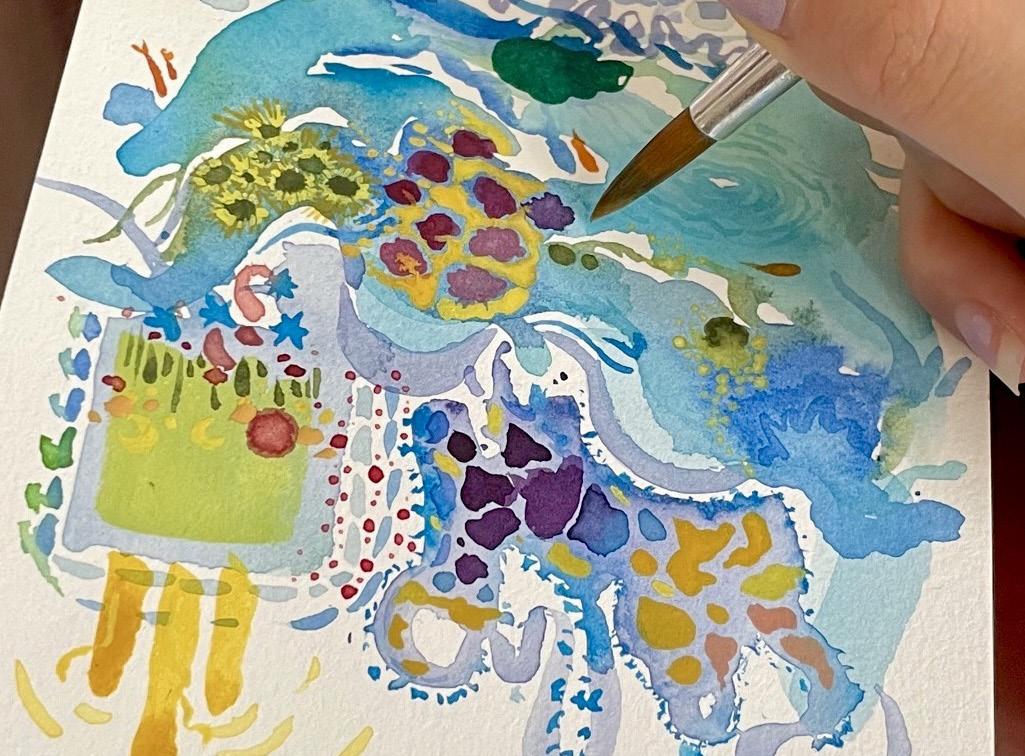
years for the first time. Seeing my work on display and receiving so many kind comments and heartfelt appreciation really affirmed what abstract art means to me.
Sometimes, I hear two voices in my head, one suggesting that yellow would go well with pink, and another saying, “No, don’t follow any colour theory, just pick the craziest combination you can think of.” Most of the time, I listen to the second voice, just to make the painting process even more unpredictable and fun. And as always, I am fascinated by the unique result at the end of each piece.
Lately I’ve been practicing not judging whether a piece is good or bad when I finish. Instead, I guide myself to be more open, humble, and understanding toward these creations rather than have bias toward it.
So, I highly encourage you to try this intuitive style of art-making, and don’t judge yourself at the end. This method offers a meditative and personally rewarding experience.
If you’re interested in seeing the results of my own intuitive practice, my work is currently on display at the Blackwood Gallery as part of the graduating student exhibition, Do Not Go Gentle Into That Good Night, which runs until April 11. You are warmly invited!
11 sports & health
Targeting teamwork: The Archery Club at UTM
Tyler Medeiros Staff Writer
An overview of UTM’s Archery Club, their President Gregory Tam, and how to get involved.
The UTM Archery Club
The UTM Archery Club is run by students for students. The organization provides a fun and inclusive environment for all UTM students interested in improving their archery skills at the beginner, intermediate, or advanced level. The club provides also welcomes students who have aspirations of becoming an archery coach, and provides training for these individuals.
The UTM Archery Club offers a wide range of fun and engaging activities on campus and beyond. One of its most popular events is the balloon-popping challenge. Archers aim their bows away from the bullseye and onto the balloons, hoping to make them burst for all to see and hear. The goal of the event is to relieve some of the mid-term stress many students experience. The event took place in October but is expected to return in the 2025-26 school year!
The inter-university archery tournament is one of the biggest annual archery events that the organization here at UTM is a part of. Archery clubs from Carleton, McMaster, TMU, York, Waterloo, and many other local schools come together to compete against each other. This year’s event recently took place on March 22 at York University.
The Archery Club also hosts social gatherings where members and interested students can get to know a little bit more about
what the club has to offer and connect with its members. In the past, the club has hosted meet and greet events with free food and board games to enjoy. Members of the Archery Club have also organized outings off campus at the Rec Room.
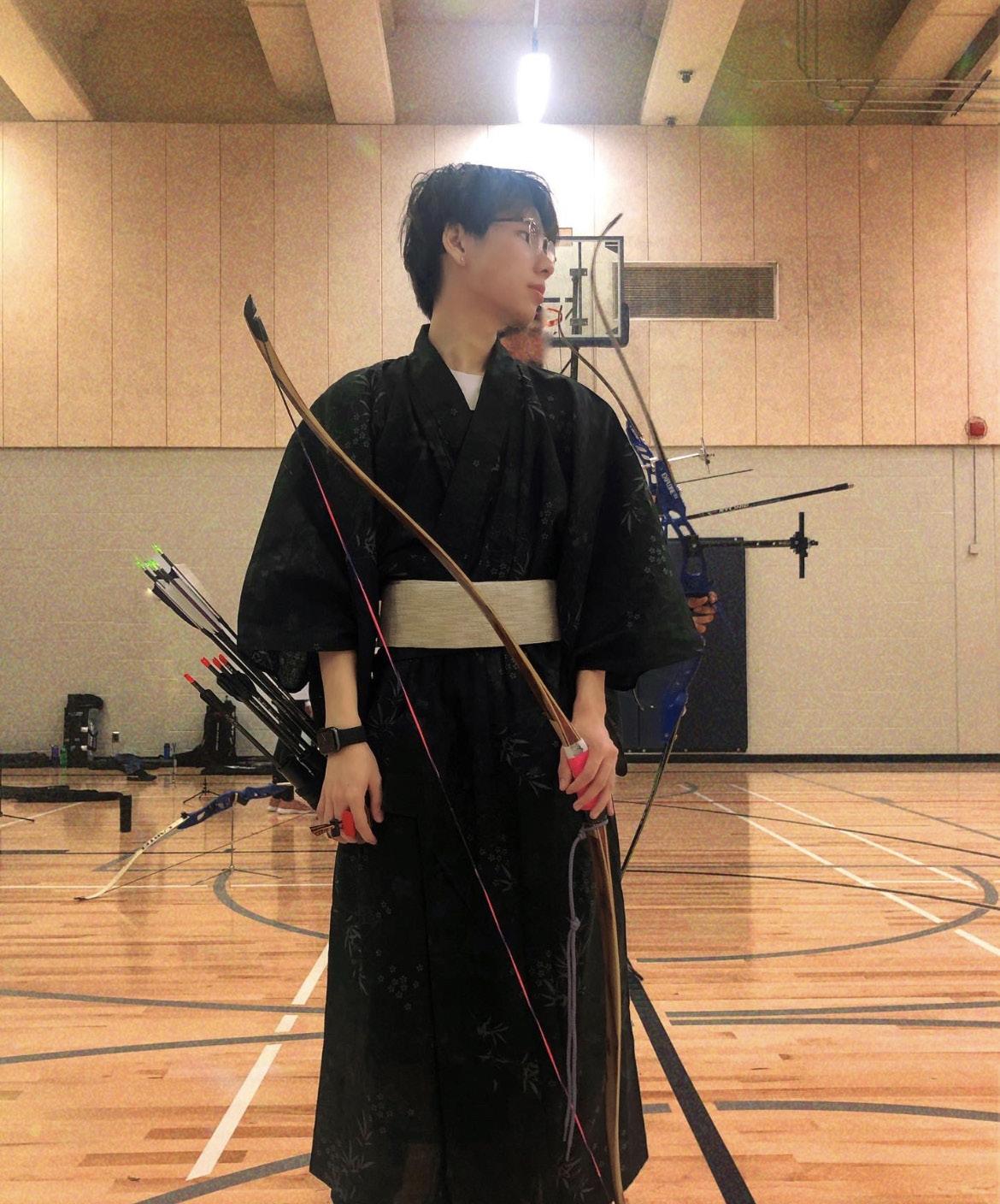
Photo by James Jin
Meet the President: Gregory Tam
I had the honor of speaking to the UTM Archery Club president Gregory Tam. Gregory is a fellow UTM student who has been practicing archery for 11 years. His archery career began in Hong Kong where he competed in numerous tournaments. Gregory competed in an archery tournament in high school

Editor | Joseph Falzata sports@themedium.ca
where he finished first place and won a gold medal for his accomplishment.
Gregory arrived at UTM and was immediately interested in becoming part of the Archery Club. He started training with the team and eventually became an executive. Gregory later went on to become the president of the club and has been serving for 2 years.
“Now, as I prepare to graduate, I’m proud to see how much the club has grown,” said Gregory.
Gregory also trained to become a certified archery coach through the club, and is now able to coach archers and help students become certified coaches.
Getting Involved
Archery can be a difficult sport to get involved in with a club or organization off campus as the equipment needed to participate can be quite expensive. Archers who are looking to compete at the highest level can expect to pay upwards of $2000 for a full set of equipment.
The Archery Club here at UTM provides an accessible point of entry into the sport with registration fees ranging from $25$50 depending on the type of membership. This participation fee helps the club maintain and improve equipment, and enhance the overall student experience with the organization.
If you are interested in finding out more about what the UTM Archery Club has to offer, you can visit their Instagram page or complete the Google form to register now!
Eagles take both Championships in thriller finals
ter Mohaisen was unavailable for the final.
from Emma Darini.
Pietro Arrigoni Staff Writer
UTM soccer brings home two more tri-campus titles, team calls for the return of Varsity sports.
Rispetto per tutti, paura di nessuno.
“Respect for everybody, fear of no one,” is an Italian phrase that you can expect to hear anywhere from the soggy changerooms of a Sunday league team to the changerooms inside the San Siro stadium ahead of a Milan derby. It’s a phrase that embodies the spirit of the sport of football perfectly. It touches on the themes of competition, fairness, and self-improvement, which I believe are the fundamentals of the sport I have grown up loving.
During my time as a UTM Eagle, I have tried to embody these values and share them with my teammates. I also firmly believe that the success we have had during the past year has been thanks to the way we have rooted our team’s mentality in these values.
A day to remember
Many were the fans who travelled to Varsity Stadium to support the Eagles in their double final. They were rewarded well for their efforts, as both the Men’s and the Women’s teams won their final games to bring home the muchawaited tri-campus indoor championship.
What happened Sunday was nothing short of remarkable. Both teams had struggled very hard in the regular season, ending up as the bottom seed heading into playoffs, and having low hopes of even making it to the finals.
Despite the odds being against them, the Eagles put in great semi-final performances that saw them reach the finals with strong momentum. Even so, the Eagles remained underdogs, seeing as how their form in the regular season had been inconsistent.
Double champs
The regular time result was goalless, and as extra-time approached the final whistle, the coaches were already discussing who would be their penalty-takers. The players on the field felt
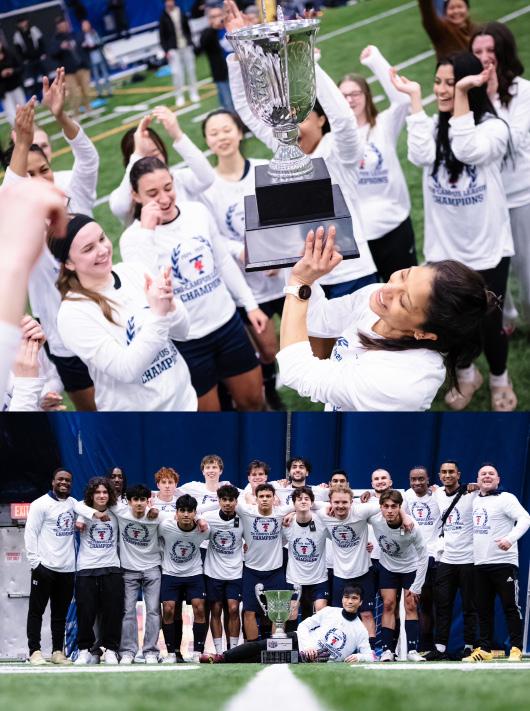
The Men took on UTSC in the first game of the night. After a poor outdoor season, UTSC had turned their form around in indoor, winning both games against UTM in the regular season and eliminating UTSG Blue in penalties to advance to the finals.
The task at hand was big, as the Men were asked to defend their status as champions against a team hungry for success. However, the Eagles’ determination to be crowned double champions drove energy in the legs of the players on the pitch, who imposed themselves on the game in a way that was never really seen throughout the season.
UTM dictated the play, remaining dangerous at all times with the combined effort of Chavan, Gideon, and Arrigoni dominating the offensive part of the game. However, they were equally attentive on the defensive side, remaining focused and disciplined while defending the UTSC attacks.
Being a final, the main focus of each team was to not concede first. Both defended sharply, but the high quality of the players on the field meant that chances were still created. Both goalkeepers had incredible performances, and a huge shout-out goes to Sze-Hock Lee, who was called into action for UTM af-
this too. The pace of the game slowed as the energy decreased. Passes became sloppier and decisions slower. In this chaotic environment, a flash of brilliance from captain Erik Selvaggi sealed the win for the Eagles. He picked up the ball just outside the box, used a decoy run by Gideon to move the defender offline and then smashed the ball off the post and into the back of the net.
The moment the ball rattled in the goal, Coach Kevin Iyamabo said he “felt enormous pride in the team and my captain, as after 65 minutes they refused to give up and got their reward.” Against all odds, the Eagles became double champions.
Underdogs to champions
The Women’s path to the trophy was arguably even harder than the Men’s. From 4th seed, they eliminated UTSG Reds, an opponent that had beaten them in all previous encounters this season. Having gone winless for the entirety of the regular season, this was a huge improvement and built tons of momentum heading into the final.
However, UTM remained underdogs in the final against UTSG Blues, who were reigning champions from the outdoor season. Despite this, UTM channeled their energy and momentum to take the fight right to Blues, grabbing an early lead with a goal
Stunned, UTSG did their best to recompose themselves and tried to regain their own momentum. The Eagles remained calm and kept possession, knocking the ball around and frustrating their opponent, while waiting for the opportunity to pounce and double their lead.
The resistance lasted until the end of the first half, when a well-worked UTSG build-up forced the Eagles defender into a late challenge that caught the striker just as she readied to tap the cross in the open net at the back post. The UTSG Blues converted the resulting penalty and the teams headed into halftime on parity.
The Eagles came out flying in the second half. Midfielder Amelia Caron controlled the game, dominating the midfield and imposing her presence across the field. As her confidence grew with the team’s momentum, she secured a lead for UTM after sitting down the defender by cutting the ball onto her weak foot and surgically placing the ball off the far post, impossible for the keeper to reach.
When UTSG stepped their line in search of a late equaliser, Jordan Pawlowski and Caron linked up to seal the game. After winning possession back, Amelia sent Jordan with a great penetrating pass that split the defence, then inflated the net after sitting down the goalkeeper.
When the final whistle blew the score read 3-1 for UTM, the bench erupted in joy, ecstatic for the incredible achievement the group had been able to reach. In that moment, the cheers and claps of the numerous fans carried away with them the memories of the struggles the girls faced throughout the season. Now, they too can call themselves champions.
A message from the team
Just a few weeks ago, no one would’ve bet on either of the Eagles’ team to take home the trophy. Yet, their incredible efforts have led to a year-defining championship win that is more than deserved. The relentless work the student-athletes and the coaches have put in this semester has reaped its rewards.
This amazing success is something players will cherish and be proud of for a long time: a farewell to those graduating and, hopefully, the beginning of a virtuous winning cycle for those who are here to stay.
However, in the midst of trophy lifting pictures and emotional hugs, there is also a clear message: UTM is ready for Varsity sports to come back. Everyone is well aware of the Varsity tradition that UTM had before the pandemic and these successes are concrete proof that tri-campus sports might be ‘tight’ for the quality of the student-athletes here.
A warm thank you goes out to everyone who contributed to the amazing season: coaches, players, and the staff. And as always, Go Eagles!
